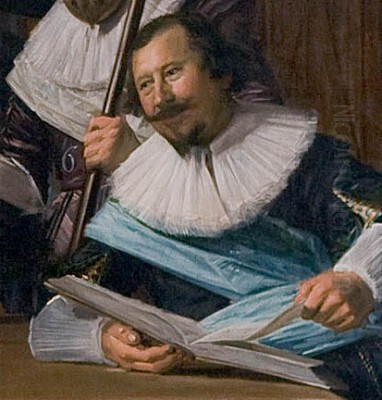
Hendrick Gerritsz. Pot stands as a notable figure in the rich tapestry of the Dutch Golden Age of painting. Active primarily in Haarlem and Amsterdam, with a significant interlude in London, Pot demonstrated remarkable versatility. He navigated the worlds of intimate genre scenes, formal portraiture, and pointed allegorical works, leaving behind a legacy that reflects the artistic vibrancy and complex social mores of the 17th century Netherlands. Though perhaps less universally recognized today than contemporaries like Rembrandt van Rijn or Frans Hals, Pot's contributions are significant, offering unique insights into the period's tastes, anxieties, and artistic dialogues.
Origins and Artistic Formation
Born in Amsterdam around 1580 or 1585, Hendrick Pot's early life and training remain somewhat shrouded in the mists of time. However, art historical consensus often links his formative years to the bustling artistic centre of Haarlem. It is widely speculated, though not definitively proven, that he may have received training from the influential Haarlem master Frans Hals. The stylistic echoes, particularly in the lively characterization found in some of Pot's portraits and genre figures, lend credence to this theory.
Another potential early influence is Karel van Mander the Elder, the painter and, more importantly, the biographer whose Schilder-boeck (Book of Painters) of 1604 was a foundational text for artists of the period. While direct tutelage under Van Mander is uncertain, his artistic principles and the models he championed would have been part of the intellectual currency in Haarlem's artistic circles. Pot certainly emerged as an artist deeply engaged with the prevailing trends and techniques of his time.
By the early 1600s, Pot was establishing himself as an independent master. His presence in Haarlem is documented, and he became an active member of the city's Guild of Saint Luke, the professional organization for painters and other craftsmen. This membership was crucial for any artist wishing to take on pupils, sell work openly, and participate fully in the city's artistic economy.
The Haarlem Years: Guild Activities and Merry Companies
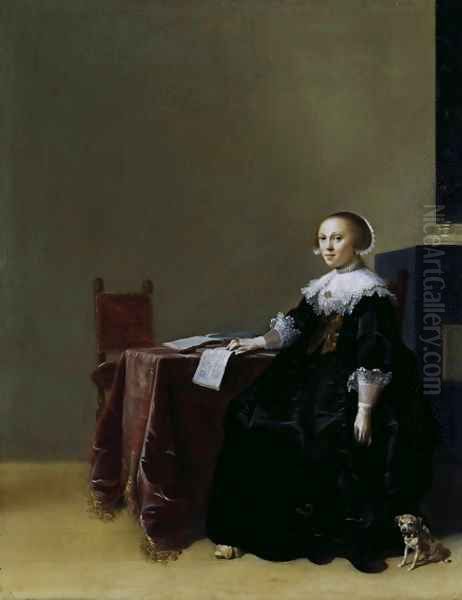
Pot's involvement in the Haarlem Guild of Saint Luke was substantial, indicating his respected position within the artistic community. Records show he served as the Guild's dean (or deken) on multiple occasions, specifically in 1626, 1630, and 1635. He also held other leadership roles, such as vinder (director or finder), in 1634 and 1643. These positions underscore his standing among his peers and his engagement in the governance of the local art world.
During his Haarlem period, Pot became particularly known for his contributions to the "Merry Company" genre. These paintings typically depict groups of elegantly dressed men and women engaged in leisurely pursuits – making music, drinking, dining, flirting, or playing games. While seemingly straightforward celebrations of conviviality, these scenes often carried subtle, and sometimes not-so-subtle, moralizing undertones, warning against excess and vanity.
Pot excelled in this genre, following in the footsteps of artists like Willem Buytewech, often called "Gheestige Willem" (Witty Willem), who was a pioneer of the elegant Merry Company scene in Haarlem. Pot's works in this vein, such as A Merry Company at Table (c. 1635), showcase his ability to render rich fabrics, capture animated social interactions, and infuse the scene with a sense of lively, if sometimes ambiguous, atmosphere. These paintings often feature symbolic elements related to the senses, transience, or temptation.
His figures are often characterized by elongated forms and somewhat stylized features, distinguishing his work from the more robust realism of Frans Hals or the peasant scenes of Adriaen van Ostade or Adriaen Brouwer, who were also active in Haarlem. Pot's Merry Companies occupy a space between elegant courtliness and bourgeois leisure, reflecting the aspirations and anxieties of the Dutch Republic's prosperous merchant class.
Portraiture: Capturing Likeness and Status
Alongside his genre scenes, Hendrick Pot was a sought-after portraitist. His approach varied, ranging from formal, commissioned likenesses to more imaginative character studies. He painted individual portraits, group portraits, and tronies – studies of heads or character types that were not necessarily intended as specific likenesses but explored expression or costume.
His portrait style often reveals the potential influence of Frans Hals, particularly in the attempt to capture a sense of immediacy and psychological presence. However, Pot's brushwork is generally tighter and more refined than Hals's famously loose and dynamic technique. He paid meticulous attention to the rendering of clothing, lace, and accessories, details that conveyed the sitter's social standing.
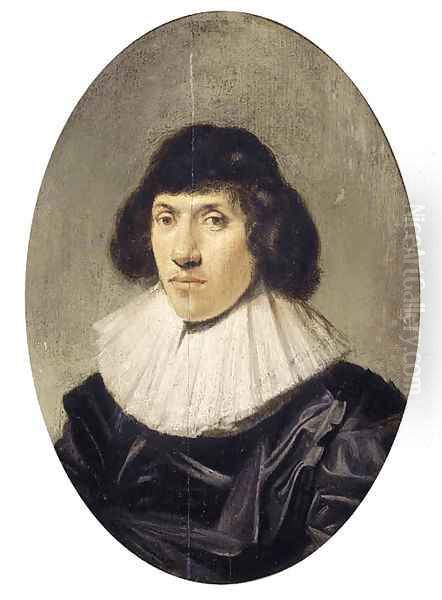
Examples like Portrait of a Young Woman (c. 1635) and Portrait of a Gentleman (c. 1635) demonstrate his skill in capturing individual features while adhering to conventions of formal portraiture. These works often incorporate subtle symbolic elements, linking them thematically to his genre paintings. The inclusion of objects like flowers, watches, or specific gestures could add layers of meaning related to virtue, transience, or the sitter's profession or inclinations.
Pot also experimented with less conventional portrait formats. His Portrait of a Man dressed as Shepherd (c. 1635) participates in the pastoral tradition popular in the Netherlands, where sitters adopted idealized rustic guises. This trend, also seen in the work of Utrecht Caravaggisti like Gerard van Honthorst, allowed for a blend of portraiture and idealized genre.
The London Interlude: Royal Patronage
A significant episode in Pot's career was his journey to London in 1632. He travelled to the court of King Charles I, a renowned connoisseur and patron of the arts. This visit placed Pot in an environment dominated by the Flemish master Anthony van Dyck, who had recently arrived and was revolutionizing English portraiture with his elegant and sophisticated style.
During his time in London, Pot received prestigious commissions to paint portraits of the royal family. He is known to have painted likenesses of King Charles I, Queen Henrietta Maria, and their son, the young Prince of Wales (later Charles II). These works, often small-scale and meticulously finished, sometimes on copper panels, showcase Pot's ability to adapt to the demands of courtly representation.
While his stay was relatively brief, the exposure to the English court and the work of Van Dyck may have influenced his subsequent style, perhaps encouraging a greater degree of refinement and elegance in his portraiture. This international experience was relatively uncommon for Dutch artists of his generation, setting Pot apart from many contemporaries who spent their entire careers within the Netherlands, such as Pieter Codde or Willem Duyster in Amsterdam.
Return to the Netherlands: Allegory and Satire
Upon returning from London, Pot resumed his career in the Netherlands, dividing his time primarily between Haarlem and, later, Amsterdam, where he eventually settled around 1648 and remained until his death in 1657. His later work continued to explore portraiture and genre, but he also produced some of his most striking allegorical and satirical paintings during this period.
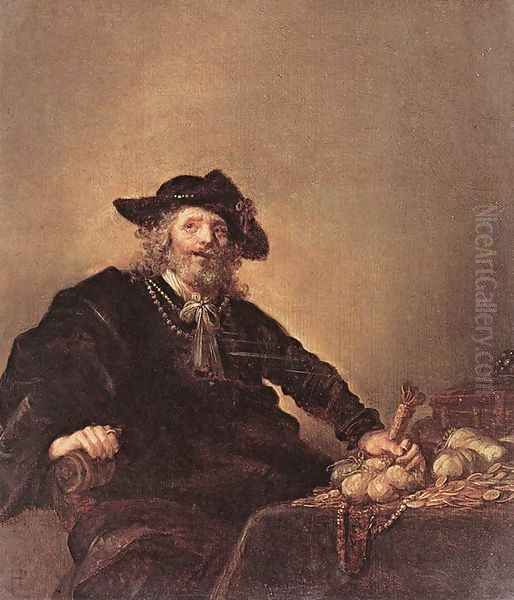
One of his most famous works is the Vanitas Allegory (c. 1633). This painting is a masterful example of the Vanitas theme, a genre particularly popular in the Calvinist Netherlands that served as a reminder of the fleeting nature of life, the futility of earthly pleasures, and the certainty of death. Pot depicts a richly dressed young woman contemplating symbols of transience and vanity: a skull, an hourglass, jewelry, luxurious fabrics, and wilting flowers. The meticulous rendering of these objects contrasts sharply with the somber message.
Another significant later work is Flora's Wagon of Fools (also known as Flora's Mallewagen), painted around 1637. This complex allegorical painting satirizes the speculative frenzy known as "Tulip Mania," which had gripped the Netherlands between 1634 and 1637. Fortunes were made and lost overnight through speculation on tulip bulbs. Pot depicts Flora, the goddess of flowers, riding in a cart pulled by the wind (symbolizing fickleness) and accompanied by drinkers and fools, heading towards the sea (representing loss). Weavers (whose livelihoods were neglected for speculation) are shown in the background. This work is a powerful piece of social commentary, akin to satirical prints of the era, but executed with the richness of an oil painting. It demonstrates Pot's engagement with contemporary events and his willingness to use art for social critique.
Works like The Miser (c. 1645) and The Coin Collector further explore themes of greed and avarice, common subjects in Dutch art that reflected moral concerns about the rapid accumulation of wealth in the Republic. These paintings often employ sharp characterization and symbolic details to convey their message, placing Pot alongside artists like Jan Steen, who also frequently depicted moral lessons through genre scenes, albeit often with more boisterous humor.
Artistic Style: Technique and Themes
Hendrick Pot's style is characterized by a blend of careful observation, refined technique, and thematic depth. While adaptable, certain features recur throughout his oeuvre. His brushwork, though potentially influenced by Hals's dynamism, generally tends towards greater precision and smoothness, especially in the rendering of textures like silk, velvet, and metal. He favored rich, often jewel-like colors, particularly in his genre scenes and allegories.
His compositions are typically well-structured, whether depicting intimate indoor scenes or more complex allegorical arrangements. He effectively used light and shadow to model forms and create atmosphere, though perhaps without the dramatic chiaroscuro employed by Rembrandt or the Utrecht Caravaggisti.
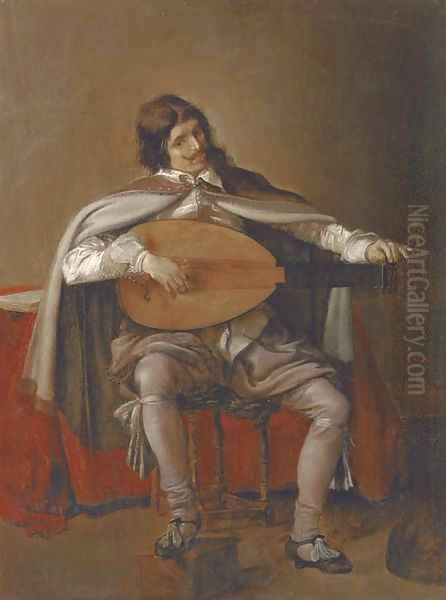
Thematically, Pot consistently returned to explorations of human behavior, social customs, and moral questions. His Merry Companies delve into the pursuit of pleasure and social interaction, often hinting at underlying tensions or consequences. His portraits capture individual likeness while simultaneously commenting on status and identity. His allegories, particularly the Vanitas paintings and Flora's Wagon of Fools, directly address profound concerns about mortality, folly, and the dangers of worldly attachment.
The use of symbolism is central to Pot's work. Objects are rarely mere decoration; they often carry specific meanings understood by his contemporary audience. Wine glasses might signify pleasure but also fragility; musical instruments could represent harmony or fleeting sensory experience; skulls and hourglasses are overt symbols of death and time. This symbolic language connects Pot firmly to the broader traditions of Northern European art, stretching back to earlier masters like Hieronymus Bosch and Pieter Bruegel the Elder.
Connections and Contemporaries
Pot's career unfolded during a period of intense artistic activity in the Netherlands. He was part of a vibrant network of artists, particularly in Haarlem. His relationship with Frans Hals, whether as pupil or simply as a younger contemporary working in the same city, is undeniable in terms of influence. He would also have known other prominent Haarlem artists like Judith Leyster, a successful painter of genre scenes and portraits, and her husband Jan Miense Molenaer. The landscape painters Salomon van Ruysdael and Jan van Goyen were also active in or associated with Haarlem during this time.
In Amsterdam, where he spent his later years, Pot would have been aware of the towering figure of Rembrandt, who had moved there in 1631. While direct evidence of personal interaction between Pot and Rembrandt is lacking, they inhabited the same urban art world. They may have shared connections through figures like the influential art dealer Hendrick Uylenburgh, who employed Rembrandt and was related to Rembrandt's wife, Saskia. Both artists explored themes like Vanitas and engaged deeply with portraiture, though their stylistic approaches diverged significantly.
Pot's work also shows awareness of trends beyond Haarlem and Amsterdam. His elegant figures sometimes recall the work of Amsterdam painters like Pieter Codde and Willem Duyster, or even the guardroom scenes of Jacob Duck, active in Utrecht and The Hague. His London visit brought him into contact with the international Baroque style represented by Van Dyck and, later, Peter Lely.
Art Historical Significance and Legacy
Hendrick Gerritsz. Pot occupies a distinct and important place in Dutch Golden Age art. While perhaps not reaching the revolutionary heights of Rembrandt or the sheer bravura of Hals, he was a highly skilled, versatile, and thoughtful painter who made significant contributions across multiple genres. His work provides valuable insights into the social life, cultural preoccupations, and moral landscape of the 17th-century Netherlands.
His Merry Company scenes are key examples of this popular genre, capturing the blend of elegance and underlying moral commentary characteristic of the period. His portraits offer sensitive likenesses that reflect the status and self-perception of his sitters, including the English royal family. His allegorical works, especially the Vanitas Allegory and Flora's Wagon of Fools, stand as powerful statements on universal themes of transience and folly, as well as pointed critiques of contemporary events.
For a time, Pot's reputation may have been somewhat overshadowed by his more famous contemporaries. However, his work has consistently been held in high regard by connoisseurs and museums. Today, his paintings are found in major collections worldwide, including the Rijksmuseum in Amsterdam, the Mauritshuis in The Hague, the Frans Hals Museum in Haarlem (which holds Flora's Wagon of Fools), the National Gallery in London, the Uffizi Gallery in Florence, and many others.
Modern scholarship continues to appreciate Pot's technical skill, his thematic range, and his unique position within the Dutch art scene. He is recognized not just as a follower of Hals or a minor master, but as an independent artist with a distinct voice, capable of producing works of considerable elegance, psychological insight, and intellectual depth. His oeuvre remains a testament to the richness and diversity of painting during one of art history's most fertile periods.
Conclusion
Hendrick Gerritsz. Pot navigated the dynamic art world of the Dutch Golden Age with skill and intelligence. From the lively taverns and elegant homes depicted in his Merry Companies, to the formal likenesses captured in his portraits, and the profound moral lessons embedded in his allegories, Pot's work offers a multifaceted reflection of his time. His journey from Amsterdam and Haarlem to the court of Charles I in London and back again speaks to a career engaged with both local traditions and international currents. As a master of genre, portraiture, and allegory, Hendrick Gerritsz. Pot remains a significant figure whose paintings continue to engage and enlighten viewers centuries after their creation.